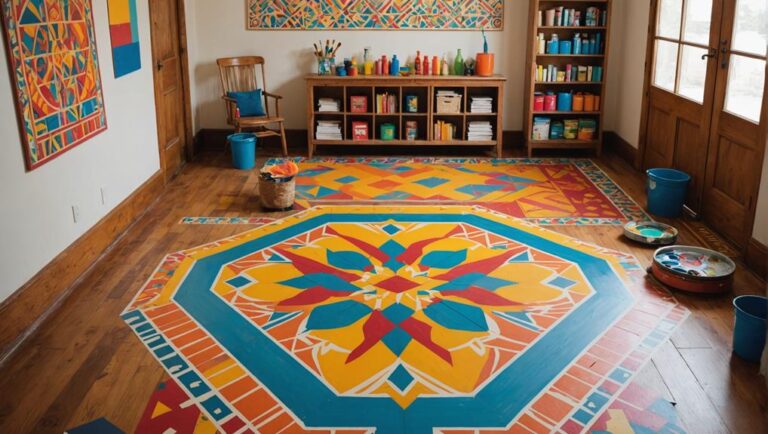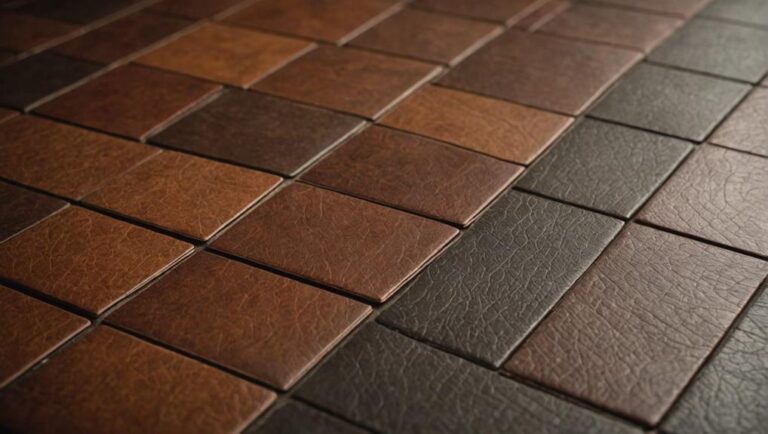Sealing outdoor stone floors is essential for enhancing their durability against weather elements. It prevents moisture infiltration, reducing the risk of cracking and deterioration. You'll find two main types of sealants: penetrating and topical. Penetrating sealants create chemical barriers, while topical forms protective films. The right choice depends on your stone type and local conditions. Proper sealing minimizes mold growth and preserves the stone's natural beauty. Application involves cleaning the surface and applying the sealant in thin layers, ensuring an even finish. For lasting results, regular maintenance and timely resealing are key, and there's much more to discover about optimizing stone care.
Importance of Sealing Stone Floors
When it comes to maintaining outdoor stone floors, the importance of sealing can't be overstated. Sealing not only enhances the aesthetic appeal of your stone surfaces but also plays a vital role in stone floor preservation. Without proper sealing, your outdoor stone can become porous, allowing water, dirt, and harmful substances to penetrate the material. This can lead to significant damage, including discoloration, cracking, and even structural integrity issues over time.
Proper sealing provides a protective barrier that minimizes water absorption, thereby reducing the risk of freeze-thaw damage in colder climates. It also helps prevent the growth of mold and mildew, which can pose health risks and create slippery surfaces that are unsafe to walk on. By sealing your outdoor stone floors, you're taking proactive steps toward outdoor surface protection, ensuring that your investment lasts longer and remains visually appealing.
Moreover, sealed stone floors are easier to clean and maintain. Regular cleaning becomes more efficient, as dirt and stains are less likely to bond with the stone. This not only saves you time but also reduces the need for harsh cleaning chemicals that could compromise your safety.
Types of Sealants Available
Sealing your outdoor stone floors requires selecting the right type of sealant to guarantee maximum protection and longevity. Two primary categories of sealants exist: penetrating sealants and topical sealants. Understanding these options is essential for ensuring the safety and durability of your stone surfaces.
Penetrating sealants, often referred to as "invisible" sealants, work by soaking into the stone's pores. They form a chemical barrier that prevents water and other contaminants from penetrating the surface. This type of sealant is particularly effective for natural stones, such as granite or limestone, where moisture absorption can lead to cracking or staining. By allowing the stone to breathe, penetrating sealants help maintain its natural appearance while providing long-lasting protection.
On the other hand, topical sealants create a protective film on the surface of the stone. These sealants are available in various finishes, from high-gloss to matte, allowing you to choose the aesthetic that best suits your space. While topical sealants provide excellent resistance to stains and wear, they can wear down over time due to foot traffic and environmental exposure. Regular maintenance is necessary to preserve their protective qualities.
When selecting a sealant, consider factors such as the type of stone, environmental conditions, and the level of foot traffic your outdoor space experiences. By choosing the appropriate sealant, you can enhance the durability and safety of your outdoor stone floors, ensuring they remain attractive and functional for years to come.
Benefits of Sealing
Applying a sealant to your outdoor stone floors provides numerous advantages that enhance both their appearance and longevity. One of the primary benefits is protection against moisture infiltration. Sealant materials create a barrier that prevents water from penetrating the stone, which can lead to cracking and deterioration over time. This is especially vital in climates where freeze-thaw cycles occur, as trapped moisture can expand and cause significant damage.
Additionally, sealing your stone floors enhances outdoor aesthetics by maintaining the natural color and texture of the stone. A high-quality sealant can enhance the stone's inherent beauty, giving it a polished look while also preventing stains from spills, dirt, and debris. This not only keeps your outdoor space looking appealing but also minimizes maintenance efforts, allowing you to enjoy your environment without the constant worry of damage or unattractive stains.
Furthermore, sealed stone floors are less prone to the growth of mold and mildew, which can be both unsightly and a safety hazard. By reducing these risks, you're not only ensuring a safer walking surface but also promoting a healthier outdoor environment. Finally, sealing can increase the longevity of your stone floors, ultimately saving you money on repairs or replacements in the long run. By investing in sealant materials, you're making a proactive choice for both aesthetics and durability, enhancing the overall experience of your outdoor living space.
Application Process
With the benefits of sealing firmly established, it's important to understand the application process to achieve ideal results. Proper sealing requires meticulous preparation steps and the right application tools to guarantee a durable finish.
First, you'll want to thoroughly clean the stone surface to remove dirt, debris, and any existing sealant residue. You can use a pressure washer for this task or a stiff-bristle brush with a suitable cleaner. Allow the surface to dry completely before proceeding.
Next, gather your application tools. A roller or a high-quality paintbrush is typically recommended for applying sealant evenly. Additionally, have a paint tray, drop cloths, and gloves on hand to protect your work area and yourself.
Here's a quick reference table for the application process:
| Step | Description |
|---|---|
| 1. Preparation | Clean the surface and let it dry |
| 2. Tools Gathering | Gather roller, brush, paint tray, gloves |
| 3. Sealant Application | Apply sealant in thin, even layers |
| 4. Curing | Allow sealant to cure according to the manufacturer's instructions |
When applying the sealant, work in small sections and avoid over-saturating the stone. After applying the first coat, check for any pooling and remove excess sealant promptly. Following these steps guarantees a professional finish that enhances the longevity and appearance of your outdoor stone floors.
Maintenance Tips for Longevity
Maintaining outdoor stone floors is fundamental for preserving their appearance and extending their lifespan. To guarantee durability, you should adopt effective cleaning techniques that won't harm the stone. Start by using a soft-bristle broom or a vacuum designed for outdoor surfaces to remove dirt and debris. For deeper cleaning, a mixture of warm water and a pH-balanced stone cleaner is ideal. Avoid acidic or abrasive cleaners, as they can damage the stone's surface and its protective seal.
When it comes to weather considerations, it's imperative to be proactive. During winter months, make sure snow and ice are removed promptly to prevent slipping hazards and freeze-thaw damage. Use a plastic shovel rather than metal to avoid scratching the stone. In summer, consider scheduling cleanings after heavy storms to remove any organic debris that can lead to staining or mold growth.
Regular inspections are essential. Look for cracks or chips, and address these issues immediately to prevent further damage. Resealing your stone floor every few years, depending on your specific environment, is also recommended. If your area experiences extreme weather conditions, such as heavy rain or intense sunlight, you might need to reseal more frequently to maintain the integrity of your stone.
Frequently Asked Questions
Can I Seal Stone Floors in Winter?
You can seal stone floors in winter, but there are winter sealing challenges to take into account. Temperature factors are vital; most sealants require a minimum temperature to cure effectively, often above 50°F (10°C). If it's too cold, the sealant may not bond properly, leading to peeling or ineffective protection. Always check the manufacturer's guidelines for specific temperature limits and verify the surface is dry and clean to achieve the best results. Safety first!
How Often Should I Reseal My Stone Floors?
You might think resealing stone floors isn't necessary, but regular maintenance is essential for longevity. Generally, you should reseal your stone floors every one to three years, depending on traffic and sealant types used. High-traffic areas may require more frequent attention. Always check for wear and tear; a simple water test can help. Keeping up with stone floor maintenance not only protects your investment but also guarantees a safe environment for everyone.
What Are the Signs My Sealant Needs Reapplication?
You can tell your sealant needs reapplication by observing its moisture resistance and overall appearance. If you notice water pooling or being absorbed rather than beading on the surface, the sealant's lifespan may be nearing its end. Additionally, if stains or discoloration appear, it's a clear sign the sealant's effectiveness has diminished. Regular inspections can help maintain safety and prolong the life of your stone surfaces, ensuring they stay protected.
Are There Eco-Friendly Sealant Options Available?
When considering eco-friendly sealant options, you'll find that natural sealants, derived from plant-based materials, offer numerous benefits. These sealants are not just safer for the environment; they also provide effective protection against moisture and stains. Unlike traditional sealants, they minimize harmful chemical emissions. Choosing a natural sealant means you're opting for durability while ensuring the safety of your surroundings. It's a win-win for both your surfaces and the planet.
Can I Seal New Stone Floors Immediately After Installation?
You might be tempted to seal your new stone floors immediately after installation, but it's vital to take into account the timing. Immediate sealing can provide benefits like enhanced protection against stains, but it's important to verify the stone is fully cured and dry. If moisture is trapped, it could compromise the sealant's effectiveness. Wait a few days to a week, depending on the stone type, for ideal results and safety. Always prioritize proper installation timing considerations.




